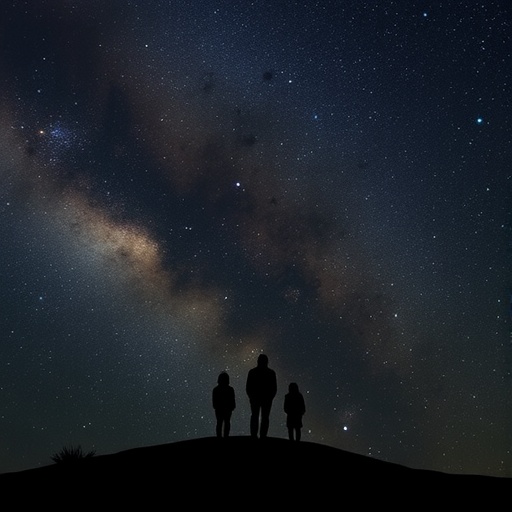Astronomers from the University of North Carolina at Chapel Hill have made a groundbreaking discovery regarding the famous Pleiades star cluster, widely known as the “Seven Sisters.” Traditionally a beloved sight during winter nights, the Pleiades is now understood to be part of a much larger stellar complex. This revelation came through the collaborative efforts of NASA’s Transiting Exoplanet Survey Satellite (TESS) and the European Space Agency’s Gaia space telescope, which allowed researchers to uncover thousands of hidden star siblings scattered across the sky. The newly defined structure has been named the Greater Pleiades Complex, indicating that this stellar family is actually 20 times larger than previously estimated.
The nature of star formation typically involves the birth of stars in groups, subsequently leading to their gradual dispersion over time. This natural drift complicates the ability to trace the origins of individual stars effectively. Researchers have employed stellar rotation rates as a sort of “cosmic clock” in their analysis, which makes it possible to distinguish younger stars that spin rapidly from older stars that rotate at a more leisurely pace. The research team at UNC-Chapel Hill successfully identified long-lost members of the Pleiades that are now dispersed across the sky. Utilizing rotation measurements from TESS alongside precise positional and motion data obtained from ESA’s Gaia, the astronomers have reimagined the Pleiades, not merely as a compact star cluster, but as a dense nucleus of a vast, dissolving stellar association.
Lead author Andrew Boyle, a graduate student in physics and astronomy at UNC-Chapel Hill, expressed how transformative this study is in reshaping perceptions about the Pleiades. Instead of being viewed solely as seven conspicuous stars, the findings reveal thousands of long-lost siblings intermingled throughout the wider celestial expanse. This kind of revelation sheds light on the complexity of stellar formations and their associations, significantly enriching our understanding of galactic structure and the life cycles of stars.
The implications of the research are far-reaching. The Pleiades serves not only as an essential astrophysical benchmark for younger stars and the burgeoning field of exoplanets, but it also holds considerable cultural significance. It has been referenced in ancient texts, such as the Old Testament and Talmud, and is culturally celebrated in various regions, including New Zealand where it is known as Matariki. Additionally, the Pleiades cluster is represented by the logo of the Subaru car company in Japan, illustrating its pervasive impact on human culture and history. Co-author Andrew Mann, a professor of physics and astronomy at UNC-Chapel Hill, underscored that this research reveals many stars in proximity to our Sun as components of extensive and complex stellar families, which were previously obscured from our view.
Through the examination of stellar rotation, the team’s innovative approach provides a refreshing framework for mapping out our galactic neighborhood. Researchers anticipate that many star clusters previously regarded as independent entities may, in fact, be segments of extensive and sprawling familial structures. Future studies leveraging this methodology could potentially help astronomers trace the origins of the Sun itself, possibly confirming whether it was born within the confines of a much larger stellar congregation.
Understanding the dynamics of stellar spin can be pivotal for identifying stellar groups that are too scattered to be recognized through traditional observational methods. This marks a significant advancement in astro-archaeology, as it opens a new window into the hidden architecture of our Galaxy. Furthermore, the research will significantly aid in reconstructing the environments in which stars and planets form—a critical step toward deciphering how solar systems, including our own, are formed and evolve over cosmic time.
The scientific community stands at the forefront of a paradigm shift in understanding the formation and evolution of star systems. The findings from this study challenge longstanding assumptions about star distribution and the familial connections that exist among stars in our galaxy. As we delve deeper into the cosmos, the lessons gleaned from the Pleiades and its newfound siblings may well illuminate not just our understanding of stellar birth, but also our place in the universe.
The researchers have attached significance to their work, emphasizing its role in rediscovering the familial relationships that exist among stars. This could potentially revolutionize our comprehension of galactic communities and encourage deeper inquiries into the shared histories and dynamics of celestial bodies. The groundwork laid by this study is a testament to what can be achieved with advanced observational technologies and collaborative research efforts.
In disseminating this new knowledge, the astrological community can expect more insights into the prevalent structures that shape our nighttime sky. For amateur astronomers and enthusiasts, this discovery fosters a deeper appreciation for the seemingly solitary stars that adorn the darkness. Each star might represent not just its individual beauty but also an elaborate web of associations extending through time and space, relying on evolutionary processes that have shaped them into the cosmos we observe today.
As preparations for further exploration and verification initiatives commence, the astronomical community remains poised to engage with these findings and to expand upon them. By using innovative techniques such as those employed in this study, new paths appear on the horizon for investigating the cosmos. The pioneering work conducted by the team at UNC-Chapel Hill has undoubtedly opened new avenues for exploration and inquiry into the intricate structures and histories that define our universe.
Above all, the rediscovered Pleiades complex serves as a vivid reminder of the intricacies, relational patterns, and profound connectivity prevalent within the cosmic tapestry. As astronomers push forward with their investigations, the secrets entwined within the Pleiades and its extended family await discovery, promising to reveal even more about the patterns of formation and evolution that govern the lives of stars.
Subject of Research: Greater Pleiades Complex and its structural implications on star formation
Article Title: Lost Sisters Found: TESS and Gaia Reveal a Dissolving Pleiades Complex
News Publication Date: 12-Nov-2025
Web References: The Astrophysical Journal
References: DOI 10.3847/1538-4357/ae0724
Image Credits: N/A




